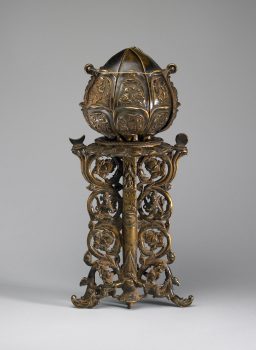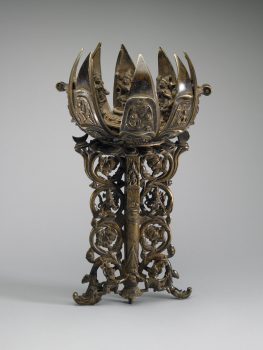Northeastern India
12th century


Northeastern India
12th century


Lotus mandalas count among the most fascinating objects of Esoteric Buddhist art. These three-dimensional representations of deity palaces typically feature a deity at the center of the flower that stands atop a tall stem, with that deity’s retinue placed on hinged petals around him or her. The sculpture’s mechanical hinges allow for those petals to close around the central deity so that the sculpture resembles a flower bud. Housing the deities in a lotus, a symbol of purity, serves as an ideal metaphor for the perfection of their palatial habitat as envisioned in meditative practice.The lotus mandala form was probably invented in northeastern India, from where most surviving examples derive. This mandala exhibits features typical for that region, including the shape of the lotus petals, the scrollwork at the sides of the stem, and the copper alloy used. At the center of its blossom is the divine couple Hevajra and Nairatmya. They are surrounded by eight yoginis dancing on the petals. On the outside of the petals are eight cemetery grounds, each presided over by a highly accomplished Tantric Buddhist adept, or mahasiddha, as is common for both two- and three-dimensional mandalas.
A contemplative practice in which a person uses concentration and visualization to achieve aims such as transforming the mind and generating feelings of compassion. Techniques include focusing on breathing or visualizing oneself as a deity.
Prescribed practices that carry symbolic meaning and value within a specific tradition and are intended to attain a desired outcome. Rituals are usually done as part of a ceremony or regular routine.
A geometrically shaped tool used for meditation and visualization in Buddhist practice. It is a representation of the palace of a deity and the Buddhist conception of the cosmos.
As the cradle of Buddhism, northeastern India was and remains today a region abundant in sacred Buddhist sites. Through the late 13th century, India was the epicenter for the production of Buddhist material and visual culture, with teachers, monks, traders, and pilgrims bringing objects back home to Tibet, western Himalayan regions, Nepal, and beyond.
Get the latest news and stories from the Rubin, plus occasional information on how to support our work.